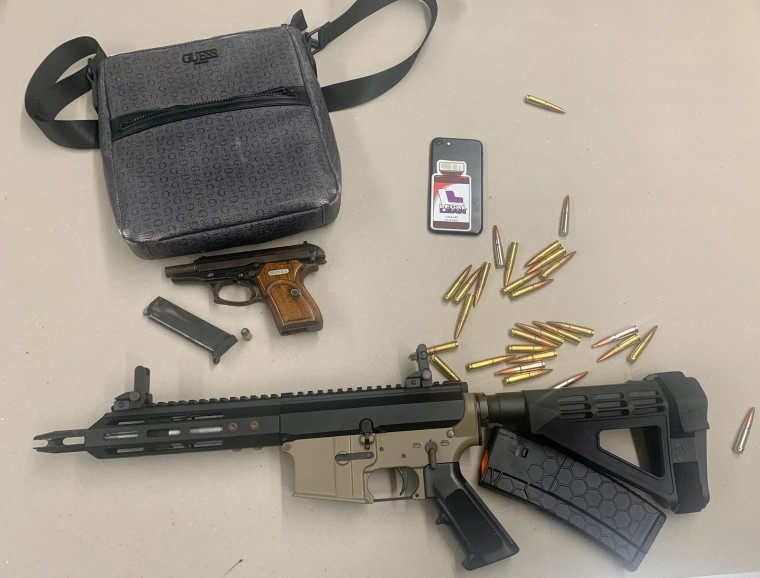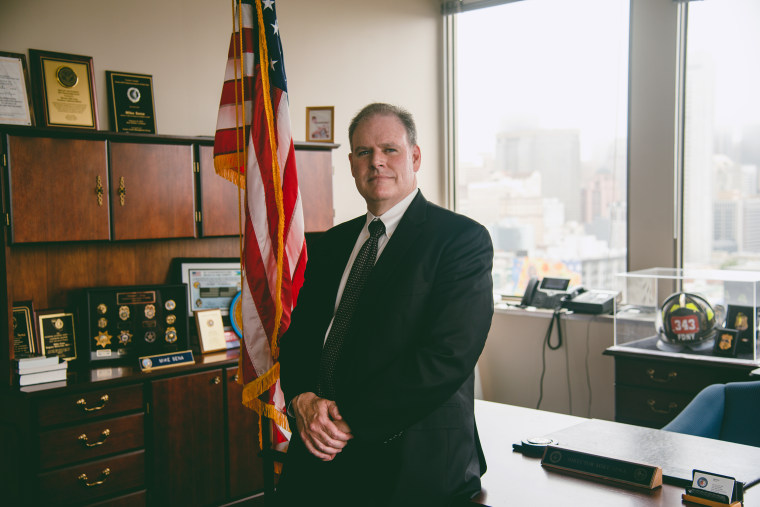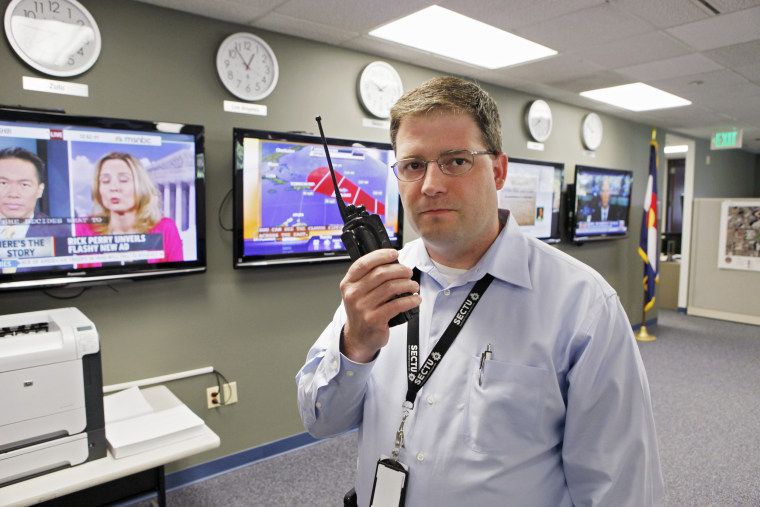In early February, the Santa Cruz County Sheriff’s Office in California came across a Snapchat post from a man saying he planned to be “shooting up” the Westfield Valley Fair mall, approximately a 45-minute drive away, in Santa Clara.
“I swear I’m literally seconds from snapping and going on a mass homicide,” wrote 21-year-old Hunter Tital.
The sheriff’s office quickly tracked down Tital’s cellphone provider and his phone's location. When they confirmed that Tital was at the mall, they called in the Santa Clara Police Department and the nearby San Jose Police Department. Officers quickly confronted Tital at gunpoint and eventually arrested him outside a Nordstrom store before most mall workers knew what had happened. Tital had a pistol and an assault rifle on him, according to the San Jose police, and later pleaded guilty, court records show.

One law enforcement group saying it worked behind the scenes to stop this potential tragedy was the Northern California Regional Intelligence Center, or NCRIC (“Nick-Rick”), one of 80 “fusion centers” — nearly all created after the Sept. 11 attacks in response to the threat of terrorism. Now nearly 3,000 people work at these fusion centers nationwide tracking down and monitoring these types of cases. In the February case, Mike Sena, the president of the National Fusion Center Association and the director of NCRIC, said the center made sure local law enforcement agencies worked together.
“We called each of those agencies and made sure that they had what they needed,” Sena said. “At the time, I knew that there was a lot of confusion between the folks at Seaside and Santa Cruz and Monterey over who had the jurisdiction on the threats and the filings on the case, and the search warrants.”

But Officer Steven Aponte, a San Jose Police Department spokesperson, the agency that arrested Tital, said that NCRIC actually did little to help with this case.
“We don't have any information showing that NCRIC was involved,” he said, noting that his department relied on information that came from the Santa Cruz County Sheriff’s Office to find the suspect, like the fact that Tital had shoulder-length, purple hair.
That confusion has raised concerns among government watchdog and civil liberties groups for years. They point to cases going back over a decade that they say show fusion centers, which cost federal and state taxpayers over $330 million a year, at best waste money and at worst often violate civil liberties. Either way, fusion centers, in the two decades since 9/11, have become a quiet part of the modern American criminal justice landscape, for better or worse.
“The practice of DHS fusion centers are, in large part, humming in the background,” said Brendan McQuade, a professor of criminology at the University of Southern Maine, and the author of a 2019 book about fusion centers, "Pacifying the Homeland." McQuade has publicly advocated to shut down the fusion center in Maine. He wrote in a June 2020 op-ed in The Bangor Daily News that “fusion centers have also been implicated in the surveillance of constitutionally protected political activity across the spectrum.”

Raising concerns
Twenty years after the Sept. 11 attacks prompted the creation of these centers, these criticisms do not seem to be waning. According to a July report by two immigrants’ rights groups and the Boston University School of Law, the fusion center in the Texas capitol, known as ARIC (Austin Regional Intelligence Center), “collects and disseminates vast quantities of data about Austin residents with minimal limitations or oversight.” But its purpose is unclear.
“Surveillance and policing and patrol does not actually prevent crime,” said Bethany Carson, an Austin-based immigration policy organizer, and one of the co-authors of the new report on ARIC. “It’s not something that can prevent crime.”
ARIC did not respond to NBC News’ requests for comment.
Political officials have raised similar criticisms for nearly a decade. In October 2012, a Senate subcommittee found that after a two-year investigation there had been “little, if any, benefit to Federal counterterrorism intelligence efforts.” Then in July 2013, a House Homeland Security Committee found that there were no “tracking mechanisms in place to provide a complete picture, even quantitatively, of how fusion center-gathered information affects Federal terrorism or criminal cases or other homeland security mission areas.”
Jake Wiener, who is a law fellow at the Electronic Privacy Information Center, a public interest research group, and an expert in fusion centers and domestic surveillance, pointed out that it’s practically impossible for outsiders to figure out what fusion centers do.
“There’s no public oversight, functionally and there’s no information coming out other than the BlueLeaks,” he said. “I think one of the questions we should be asking is: Is it worth the price tag?”
In recent years, particularly as defund the police efforts have gotten some traction in some liberal American cities, fusion centers have received even more scrutiny.
When Milwaukee County Supervisor Ryan Clancy was asked if he fully understands what the Milwaukee-based Southeastern Threat Analysis Center does, his answer was blunt.
“The short answer is no, and it’s not for a lack of effort,” he said. “To have any organization operating with the opacity that the fusion centers do — it’s kind of the Wild West. They’re operating in almost a complete lack of oversight.”
Long history
Fusion centers sprung out of the fact that, even before 9/11, few state and local law enforcement entities were able to share information and intelligence across regional and state lines, much less national ones. One common criticism by the 9/11 Commission itself was that the federal government was hampered by its own rules and regulations, concluding that the FBI specifically “was limited in several areas critical to an effective preventive counterterrorism strategy.” Pre-9/11, such federal law enforcement integration largely only existed through Joint Terrorism Task Forces.

In some ways, fusion centers were the state and local version of these task forces, but with one key distinction. While the initial wave of early 2000s-era fusion centers focused on counterterrorism, nearly all have expanded their mission to include “all-crimes and/or all-hazards.” In 2007, the Congressional Research Service found that several fusion center leaders were “more concerned with issues such as gangs, narcotics and street crime.”
Today, according to the Department of Homeland Security’s website, fusion centers serve as “focal points” to “lawfully gather and share threat-related information” among all levels of law enforcement, from local police to the FBI. Every state has at least one, along with 27 major urban area centers and three spread across U.S. territories — California alone has six centers.
According to Sena, the Valley Fair mall incident is a clear example of how fusion centers help different agencies advance everyday criminal investigations.
“Rather than trying to find the usual suspects, we are trying to identify the people that are the small number of folks in the communities that are causing the disproportionate amount of harm to the community,” he said.

Structural challenges
But critics of fusion centers say they have even more problems than the fact that nearly all of them have moved beyond aiding terrorism-related investigations.
Each fusion center is run independently and exists within what the American Civil Liberties Union called a “no man’s land between the federal government and the states.” Also while fusion centers gather vast quantities of purported suspicious activity, this data gathering rarely results in criminal prosecutions, much less convictions.
A spreadsheet published as part of the BlueLeaks trove, the 2020 publication of internal fusion center documents from around the country, for instance, showed that the fusion center found some troubling and potentially criminal incidents.
For example, in March 2020, a female employee at a Victoria’s Secret store in Barton Creek Mall in Austin, who posted on Facebook that she was upset about her hours being cut and wrote: "so my job just going to cancel employees shift so they don't have to pay us...this is why ima blow up the f---ing store." But the log states: “No device was located and the subject's employment was terminated.”
Another November 2019 incident describes a student who apparently told a teacher: "Do you know what the 2nd Amendment is? It's what gives me the right to bear arms, and bring them to school. I'm going to kill as many people as I can. I'm going to be more famous than nikolas cruz."
This student was arrested for having made a “Terroristic Threat,” the log added.
But there are also plenty of reports not tied to a specific crime. As part of the BlueLeaks document dump, in a file pertaining to ARIC, the Austin fusion center, one person recorded that a Metro Rail passenger in Austin had “changed his dress from traditional westernized clothing to ‘tunics with an Arabic style hat,’” adding that this new outfit made the person appear to be “‘tense and sweaty, and that his fists are always clenched’ while ‘mumbling’ what the caller describes sounds like Arabic.”
Another was a report from a person on a Swift Airlines flight from Nevada to Austin. That person said he saw a “Middle Eastern male in his thirties” who was looking at photos on his phone. This passenger then watched this fellow passenger as he “viewed photo of a female and kissed the screen,” and then saw a “photo showing the male having a very long beard then in the next picture he was clean shaven,” and finally a “photo showing the male wearing a black mask covering most his face then wearing a silver mask.” Based on these reports, it is not clear what, if any action was taken in Austin.
“Part of the problem post-9/11 was that information sharing was seen as the solution and there wasn’t a discussion about what information was appropriate to collect and share,” said Michael German, a fellow at the Brennan Center for Justice at New York University, and a former FBI special agent who wrote the 2007 ACLU study.
“All they started doing was collecting and sharing more dots.”
Sena, the president of the National Fusion Center Association, said that gathering these reports doesn’t suggest that a potential suspect is nefarious.
“Anyone can report something through the (suspicious activity reporting) process,” he said. “But that doesn't mean that it gets inducted into our environment unless it meets the threshold,”
At the same time, even Sena says there’s not an obvious way to know how successful his fusion center, NCRIC, or any other fusion center actually is, in practice.
“It’s really hard to connect a specific report to an arrest or a specific conviction,” he said.

